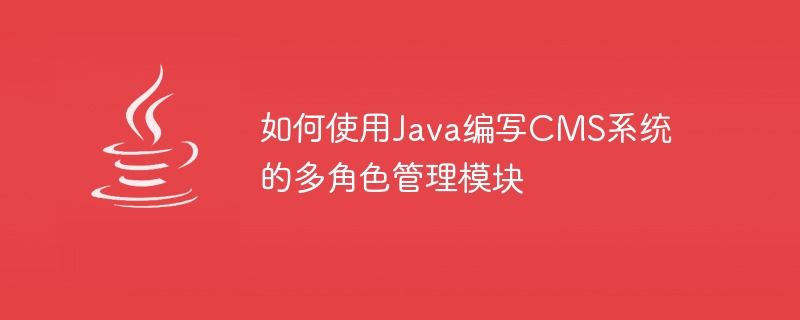

How to use Java to write the multi-role management module of a CMS system
With the rapid development of the Internet, content management systems (CMS) have been widely used in various fields. application. In a large-scale CMS system, multi-role management is one of the very important modules. Through multi-role management, system administrators can define and authorize different user roles to ensure system security and stability. This article will introduce how to use Java to write the multi-role management module of the CMS system and give code examples.
Before you start writing the multi-role management module, you first need to design the roles and permissions. Generally speaking, a role contains multiple permissions, and through the assignment of permissions, restrictions on different functions can be achieved. For example, common roles in a CMS system include administrator, editor, author, etc. Administrators have the highest authority and can operate all functions of the system; editors and authors can only edit and publish specific content.
In Java, you can use an object-oriented approach to design roles and permissions models. You can define a Role class and a Permission class. The Role class contains attributes of the role name and permission list, and the Permission class contains attributes of the permission name and permission code. The sample code is as follows:
public class Role {
private String name;
private List<Permission> permissions;
// 省略构造方法和Getter/Setter方法
}
public class Permission {
private String name;
private String code;
// 省略构造方法和Getter/Setter方法
}In the CMS system, there is a many-to-many relationship between roles and permissions. A role can have Multiple permissions, one permission can belong to multiple roles. In order to realize the relationship between roles and permissions, a relational database, such as MySQL, can be used.
In the database, you can design two tables, one to store role information and the other to store permission information. In the role table, a foreign key can be defined to relate the permissions table. The sample code is as follows:
CREATE TABLE role (
id INT PRIMARY KEY AUTO_INCREMENT,
name VARCHAR(255)
);
CREATE TABLE permission (
id INT PRIMARY KEY AUTO_INCREMENT,
name VARCHAR(255),
code VARCHAR(255),
role_id INT,
FOREIGN KEY (role_id) REFERENCES role(id)
);By using Java's persistence layer framework, such as Hibernate or MyBatis, the relationship between roles and permissions can be easily realized. The sample code is as follows:
public class Role {
private String name;
private List<Permission> permissions;
// 省略构造方法和Getter/Setter方法
}
public class Permission {
private String name;
private String code;
// 省略构造方法和Getter/Setter方法
}In the CMS system, there is a many-to-many relationship between users and roles. One user can have Multiple roles, one role can belong to multiple users. Similarly, a relational database can be used to implement the relationship between users and roles.
In the database, you can design two tables, one to store user information and the other to store the relationship between users and roles. In the user table, you can define a foreign key to relate the role table. The sample code is as follows:
CREATE TABLE user (
id INT PRIMARY KEY AUTO_INCREMENT,
name VARCHAR(255),
password VARCHAR(255)
);
CREATE TABLE user_role (
id INT PRIMARY KEY AUTO_INCREMENT,
user_id INT,
role_id INT,
FOREIGN KEY (user_id) REFERENCES user(id),
FOREIGN KEY (role_id) REFERENCES role(id)
);By using Java's persistence layer framework, such as Hibernate or MyBatis, the relationship between users and roles can be easily realized. The sample code is as follows:
public class User {
private String name;
private String password;
private List<Role> roles;
// 省略构造方法和Getter/Setter方法
}
public class Role {
private String name;
private List<Permission> permissions;
// 省略构造方法和Getter/Setter方法
}In the CMS system, permission control is a very important part. Through permission control, the system can determine whether a user has the right to perform a certain operation based on the current user's role and permissions.
In Java, you can use AOP (aspect-oriented programming) to implement permission control. You can define an aspect class and add corresponding annotations to specified methods to control permissions. The sample code is as follows:
@Aspect
@Component
public class PermissionAspect {
@Autowired
private UserService userService;
@Autowired
private HttpServletRequest httpServletRequest;
@Around("@annotation(com.example.cms.annotation.PermissionCheck)")
public Object checkPermission(ProceedingJoinPoint joinPoint) throws Throwable {
// 获取当前用户
String token = httpServletRequest.getHeader("Authorization");
User user = userService.getUserByToken(token);
// 获取注解信息
MethodSignature signature = (MethodSignature) joinPoint.getSignature();
Method method = signature.getMethod();
PermissionCheck permissionCheck = method.getAnnotation(PermissionCheck.class);
String permissionCode = permissionCheck.value();
// 判断用户是否有权限
if (userService.hasPermission(user.getId(), permissionCode)) {
return joinPoint.proceed();
} else {
throw new PermissionDeniedException("Permission denied.");
}
}
}Use the annotation @PermissionCheck to mark methods that require permission control. In the aspect class, the user's permission information is used to determine whether the user has permission to perform the corresponding operation. If the user has permission, continue executing the method; otherwise, throw an exception.
After writing the code for the multi-role management module, you can write some test code to verify whether its function is normal. The sample code is as follows:
@RunWith(SpringRunner.class)
@SpringBootTest(webEnvironment = SpringBootTest.WebEnvironment.RANDOM_PORT)
public class RoleServiceTest {
@Autowired
private RoleService roleService;
@Test
public void testCreateRole() {
Role role = new Role("admin");
roleService.createRole(role);
}
@Test
public void testGrantPermission() {
roleService.grantPermission(1, "create_user");
}
@Test
public void testRevokePermission() {
roleService.revokePermission(1, "create_user");
}
}In the test code, you can call the relevant methods of the role service to create roles, authorize and revoke permissions. You can verify that the multi-role management module is working properly by running the test code.
Summary
This article introduces how to use Java to write the multi-role management module of the CMS system and gives corresponding code examples. By designing the role and permission model, realizing the relationship between roles and permissions, realizing the relationship between users and roles, and implementing permission control, the security and stability of the CMS system can be ensured. I hope this article will be helpful to readers in implementing the multi-role management module of the CMS system.
The above is the detailed content of How to use Java to write a multi-role management module for a CMS system. For more information, please follow other related articles on the PHP Chinese website!
